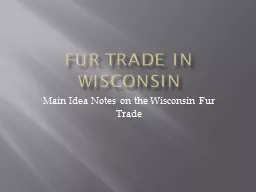PPT-Fur Trade in Wisconsin Main Idea Notes on the Wisconsin Fur Trade
Author : min-jolicoeur | Published Date : 2018-10-13
White Men Coming to WI Priests conversion to Catholicism Explorers natural resourcestrade route east Asia Had heard and seen goldriches coming back with the Spanish
Presentation Embed Code
Download Presentation
Download Presentation The PPT/PDF document "Fur Trade in Wisconsin Main Idea Notes o..." is the property of its rightful owner. Permission is granted to download and print the materials on this website for personal, non-commercial use only, and to display it on your personal computer provided you do not modify the materials and that you retain all copyright notices contained in the materials. By downloading content from our website, you accept the terms of this agreement.
Fur Trade in Wisconsin Main Idea Notes on the Wisconsin Fur Trade: Transcript
Download Rules Of Document
"Fur Trade in Wisconsin Main Idea Notes on the Wisconsin Fur Trade"The content belongs to its owner. You may download and print it for personal use, without modification, and keep all copyright notices. By downloading, you agree to these terms.
Related Documents














